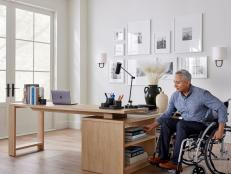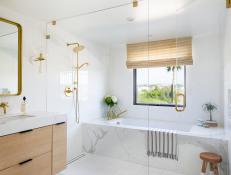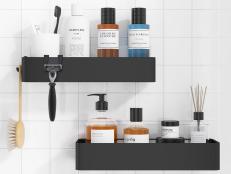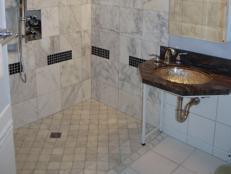Universal Design Showers: Safety and Luxury

Kohler
The telephone booth-size shower is going the way of the telephone booth. And why not? With so many great shower features out there, people want big, beautiful showers where they can soak in comfort and style. Of course, once they pour creative thinking — and dollars — into a dream shower, they want it to serve them well for a long time. Universal design, an ingenious approach that makes sure designs work for everyone, regardless of age, size, ability and changing needs, helps ensure that the shower will do just that.
When it comes to showers, universal design and luxury have a lot in common. Some of the hottest design trends — large, walk-in showers with no doors; boutique tiles; versatile shower sprays — fit right in with designs that make showers safe, accessible and enjoyable to use.
As for size, your shower should be at least three feet square and have a wide entry, so there's ample room to get in and move around. Designer Mary Jo Peterson, CKD, CBD and a universal design specialist in Brookfield, Conn., says 42 by 60 inches is even better, particularly for showers that have no door or curtain. The larger space helps keep the water from straying out and allows someone in a wheelchair or walker to maneuver with ease.
Curved or angled shower walls have both design panache and universal design advantages, helping keep water inside and offering privacy even if the shower has no door. If you do have a shower door, make sure it swings out of the traffic pattern.
No room for a big shower stall? You can turn the bathroom itself into a "wet room," another hot trend these days. In a wet room, the shower and bathroom share one big, open space that has an extra floor drain and slightly sloped floors for drainage.
Still trying to figure out how to fit a bigger shower into your small bathroom? Universal design expert Cynthia Leibrock of Easy Access to Health, Livermore, Colo., has a solution: Remove your bathtub and install a shower where the tub was. Most people prefer showers anyway, and they are generally safer and easier to use. The tub space will work fine for an accessible shower. Your contractor will have to make the shower entry barrier-free and level with the bathroom floor. Instead of a solid rim at the threshold to contain the shower water, Leibrock recommends a compressible plastic strip; it holds in the water but is easy to roll over and won't be a tripping hazard.
A Universal Shower
Okay, you've carved out the space for a universal design shower. Here's a checklist of features to make the shower work well for the whole family.
Seating. Some people want or need to sit in the shower, and some don't. If you recess a bench into the shower wall or install a fold-down seat, everyone will be happy.
Sprays and controls. An adjustable handheld shower spray is the way to go for maximum flexibility. It slides on a wall-mounted rod, and can be locked into place or pulled out on a retractable hose. In other words, it's where it needs to be, whether the person in the shower is tall or short, standing or seated.
Put the controls where they can be reached from the shower seat and from outside the shower. Leibrock advises choosing a lever or other style that's easy to grasp and turn. You'll need valves to keep the water temperature safe; as Peterson points out, controls for these belong out of reach of children.
It's a good idea, adds Peterson, to install a second shower spray overhead. That lets the kids take a shower even if Dad or Mom left the adjustable spray too high for a child to reach.
Wall niches. You'll want at least two wall niches for soap and shampoo: one by the seat for kids and seated bathers, and another up higher for standing adults.
Flooring and walls. For a non-slip floor, go with tumbled stone or non-glossy ceramic tiles, preferably mosaics or other small pieces that are embedded in a dense network of grout. Grout lines are good because they add texture, but they should be thin to keep the surface smooth.
Leibrock recommends tiling all the way up the shower walls and even across the ceiling. After all, a handheld spray can shoot water everywhere. But those swaths of tile don't have to be monotonous. Add decorative accents that look great and help orient people who may need a few visual cues as to what's where.
Lighting. You'll want good lighting in the shower and at the entry — no surprise here. But the best place for overhead lighting in the shower may not be dead center. Peterson suggests getting into the proposed shower area to figure out where to locate the light so it won't be blocked by a bather.
Grab bars. Grab bars have a bad reputation. People think they are ugly and belong only in hospitals. But grab bars now come in wonderful colors, chic shapes and elegant finishes, often coordinating with other bathroom accessories.
It's best to put grab bars at the shower entry as well as in the shower at various heights to provide welcome handholds and prevent falls. If you don't want grab bars now, at least add blocking for them while the walls are open for construction of your shower. That way, when you decide to put in a few grab bars, the job will be inexpensive and easy.
Wendy A. Jordan writes about residential design and remodeling. Her book on universal design was published in 2008.
RESOURCES
Mary Jo Peterson, CKD, CBD
Mary Jo Peterson, Inc. Design Consultants, www.mjpdesign.com
Cynthia Leibrock, MA, ASID, Hon. IIDA
Easy Access to Health, http://agingbeautifully.org













































